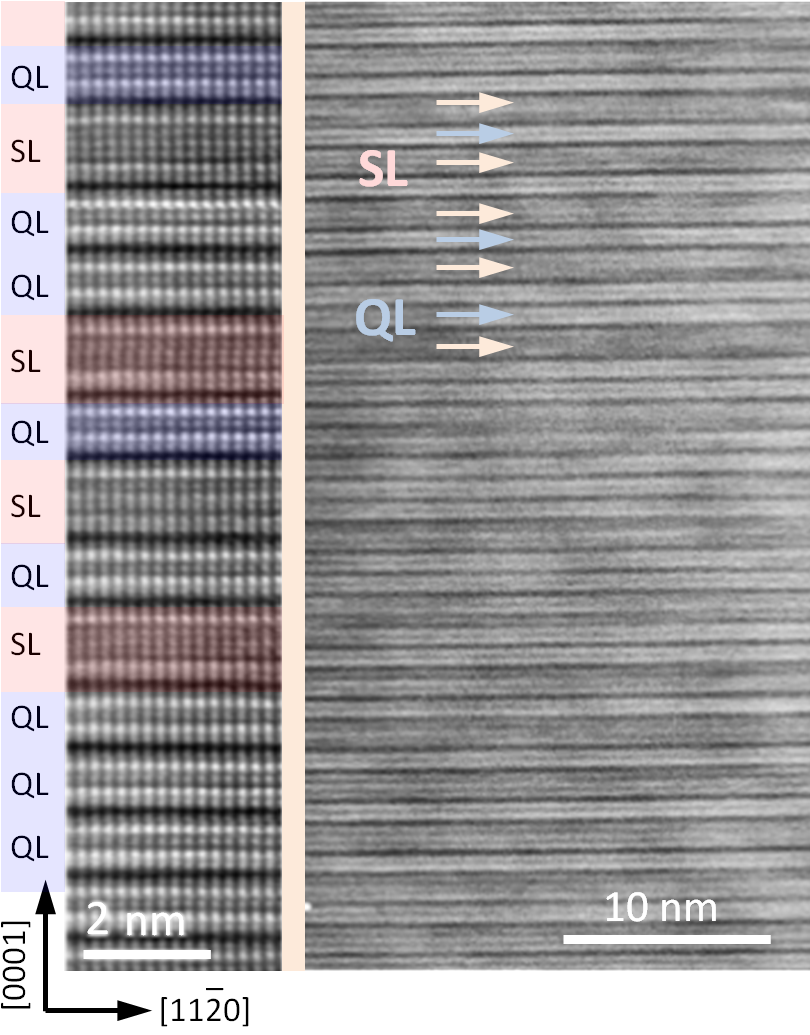Dec 19 2019
New experiments conducted at BESSY II using magnetically doped topological insulators have unraveled prospective means of lossless signal transmission involving an astonishing self-organization phenomenon.
 The TEM image shows the superstructure which is created by doping of Bi2Te3 with manganese: Between the originally 5-atom-layer thick units (QL) new 7-atom-layer units are formed by self-organization in which the manganese occupies the central layers. Image Credit: Gunther Springholz/Uni Linz.
The TEM image shows the superstructure which is created by doping of Bi2Te3 with manganese: Between the originally 5-atom-layer thick units (QL) new 7-atom-layer units are formed by self-organization in which the manganese occupies the central layers. Image Credit: Gunther Springholz/Uni Linz.
In the years to come, it might be feasible to create materials that exhibit this phenomenon at room temperature and can be employed as processing units in a quantum computer, for instance. The research has been reported in the well-known journal Nature.
Generally, in solid-state physics, new effects are first identified at temperatures close to absolute zero (0 K or −273 °C). In-depth studies can then establish whether, and in what ways, these phenomena can be initiated at room temperature as well.
Superconductivity was first detected in mercury below the temperature of 4 K over a century ago. At present, there are several high-temperature superconductors conducting electrical current without losses due to resistance at temperatures as high as 138 K or even 200 Kelvin (H2S holds this record).
Lossless Charge Transport
In 2013, for the first time, the Quantized Anomalous Hall Effect (QAHE) was detected in a magnetically doped topological insulator below the temperature of 50 mK. Analogous to superconductivity, this effect enables lossless transport of charges inside thin edge channels of the samples. At the same time, it has been realized to increase the maximum temperature at which the effect can be detected up to about 1 K.
But according to theoretical considerations, the QAHE must appear at considerably higher temperatures. Therefore, it is still obscure why this does not occur. One crucial parameter is called the sample’s magnetic energy gap, but it has not been quantified to date. If this gap is larger, the effect of the impact of temperature will be more stable.
Breakthrough at BESSY II
An international research team led by HZB physicist Prof. Dr Oliver Rader and Prof. Dr Gunther Springholz from the University of Linz has realized a major advancement. Using photoelectron spectroscopy with BESSY II synchrotron radiation, they have successfully quantified for the first time the energy gap in such a sample.
They realized this by using the equipment called ARPES1cube to achieve very low temperatures, together with the new spin-resolving potential of the Russian-German Laboratory at BESSY II. Fascinatingly, in reality, the gap was five times larger than it was proposed theoretically.
Self-Organized Superstructure
The researchers also found a basic reason for this outcome.
We now know that manganese doping does not happen in a disordered manner. On the contrary, it causes stratification known as a superstructure in the material—layers much like a puff pastry. By adding a few per cent of manganese, alternating units of seven and five layers are created. This causes the manganese to be preferentially contained within the seven-layer units and thus can generate the energy gap much more effectively.
Dr Gunther Springholz, Professor, University of Linz
According to Rader, researchers’ imaginations in the use of dopants has not widened sufficiently far until now. Trivalent elements like vanadium and chromium with magnetic characteristics were used as an alternative for the bismuth in bismuth telluride (Bi2Te3), where the dopant atoms were in a disordered state.
The reason behind this appeared very persuasive: trivalent magnetic elements offer three electrons to chemical bonds and the chemical valence of these elements leads them to the bismuth locations. When it comes to manganese, the condition is different. Manganese is bivalent, and hence is not suited to the bismuth sites.
This may be the reason why the system turns radically restructured and forms a new double layer of atoms where manganese can be bivalently added.
In this way, a structure is created—in a self-organized way—in which manganese can produce the large magnetic energy gap.
Prof. Dr Oliver Rader, Physicist, Helmholtz-Zentrum Berlin
Outlook Quantum Computing
Springholz says these self-organization phenomena could be leveraged in particular ways to develop entirely new configurations for magnetic topological materials. As a rule, the gap that has been quantified now is already so wide that it must facilitate the development of a near-room-temperature QAHE from suitable components.
But it is still necessary for other parameters to be enhanced. A magnetic topological insulator such as this, when used together with a normal superconductor, could also enable achieving a quantum processing unit (Qbit) for a quantum computer.